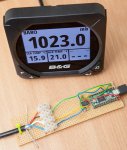skyflyer
Active member
I suspect it might be something to do with how "fussy' the receiving device is, as clearly Timo runs it as it is written on his own hardware - i don't know which MFD he has though.
(I'm having problems getting ANY dat to the N2K bus; I can get it to the serial output and from there to the Actsense NMEAReader soft are on my PC, where it is evident that the correct PGNs etc are being output, but zilch on my N2K bus - but i think I may have hardware issues.)
There would seem to be some other code related to the device ID etc as otherwise you should be able to pretend its a device from an approved manufacturer by setting their manufacture code and class and function codes accordingly? The fact that doing that produces no improvement indicates to me that there are other fields possibly that are needed?
Quite where you find them is another question!
At the moment I haven't been getting any responses from Timo either, maybe he is away. However i suspect that he will simply say "can't advise on other MFDs" as that what he has written in his documentation already! I'll give it a try though!
What we need to find is someone who has already achieved what we are trying to do.
(I'm having problems getting ANY dat to the N2K bus; I can get it to the serial output and from there to the Actsense NMEAReader soft are on my PC, where it is evident that the correct PGNs etc are being output, but zilch on my N2K bus - but i think I may have hardware issues.)
There would seem to be some other code related to the device ID etc as otherwise you should be able to pretend its a device from an approved manufacturer by setting their manufacture code and class and function codes accordingly? The fact that doing that produces no improvement indicates to me that there are other fields possibly that are needed?
Quite where you find them is another question!
At the moment I haven't been getting any responses from Timo either, maybe he is away. However i suspect that he will simply say "can't advise on other MFDs" as that what he has written in his documentation already! I'll give it a try though!
What we need to find is someone who has already achieved what we are trying to do.

